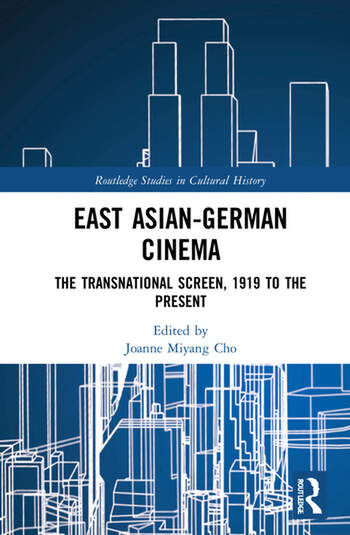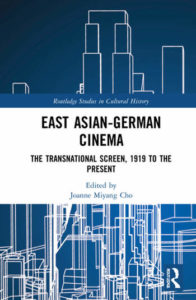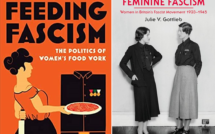
East Asian-German Cinema: The Transnational Screen, 1919 to the Present edited by Joanne Miyang Cho

The first book-length study of East Asian German cinema, the collected volume East Asian-German Cinema: The Transnational Screen, 1919 to the Present, edited by Joanne Miyang Cho, fills a long-existing lacuna in transnational cinema studies. Whereas the field of Turkish German cinema has received considerable attention in the last two decades, the same cannot be said about East Asian German cinema. East Asian-German Cinema takes studies such as Sabine Hake and Barbara Mennel’s edited volume Turkish German Cinema in the New Millennium (2012) as possible models for approaching transnational German cinema but ultimately goes in its own direction. Distinct from studies of Turkish German cinema, which typically focus on themes derived from the history of labor migration from Turkey to Germany between 1961 and 1973 and its afterlives, Cho’s book explores a much greater historical and thematic scope. It begins in the early decades of cinema itself with representations of East Asia in Weimar Cinema, which were widely present at the time. This volume furthermore examines a range of filmic objects, from fiction and documentary film to manga adaptations and new media. In her comprehensive introduction, Cho frames East Asian-German Cinema within broader discussions of national cinema, on the one hand, and what she calls “hybrid” or transnational cinema, on the other. Rigorously engaging with an expansive breadth of literature on these topics, Cho explores the development of a discourse that addresses the ever-pertinent question of what makes cinema transnational. She takes a multifold approach, showing in sum that transnational cinema hinges on global production and ideational networks; indeed, it is postcolonial, and it is multidirectional. We encounter all of these elements to a lesser or greater degree in the contributions that constitute this study.
The twelve chapters of the book are organized chronologically in four distinct sections. Across these chapters, Chinese, Japanese, and Korean narratives and representations come into focus. Part I is the longest; it includes four essays that examine the extended period from early Weimar to Nazi cinema, between 1919 and 1945, and provide an important historical entry point into the topic of East Asian German cinema. If 1918 marked the end of the First World War and Germany’s ensuing cession of its colonies, the year 1919 ushered in a new beginning. Germany began its attempt at democracy with the initiation of the Weimar Republic. This modern republic set in motion at once a period of political tumult and, inter alia, the golden age of German cinema. More specifically, 1919 marks the release year of one of Fritz Lang’s early and exceedingly orientalist films—Harakiri—which Qinna Shen explores in her opening contribution with acuity and rich illustration. Here, the reader encounters what Thomas Elsaesser also notably referred to as Weimar cinema’s “orientalism à la mode.”[1] The first three chapters examine various productions of the Weimar period with a particular focus on the German fascination with and misappropriation of Japanese culture. Part I’s final chapter is somewhat of an outlier in its investigation of three post-2000s documentaries about Jewish exilés in Shanghai during the Second World War but is no less historically important.
The chapters in Part II survey films from the 1950s and 1960s with a particular focus on racialized gender representations. In these films, Asian women are frequently portrayed as either submissive or disarming and Asian men as treacherous. Beyond their scrutiny of gender, however, the films examined in the three chapters collected here, beginning with the 1957 DEFA propaganda film The Compass Rose all the way to the Japanese manga shorts of the 1960s featuring the James Bond-like figure Golgo 13, also play with the politics of representation. These compilation films and remakes directly alter earlier or comparative filmic representations as a means to either reinforce racialized gender stereotypes or trouble them. Compass Rose is an example of the former and the 1961 melodrama Bis zum Ende aller Tage (Until the End of All Days) of the latter. As Zach Ramon Fitzpatrick points out in his contribution, this 1961 melodrama about the conflicted romance between a white German man and a Chinese woman from Hong Kong predates even Rainer Werner Fassbinder’s celebrated early portrayal of interracial love in Angst essen Seele auf (Ali: Fear Eats the Soul, 1973).
Consisting of merely two chapters, Part III briefly investigates a series of documentary and fiction films produced since the late 1970s that reflect on the direct cultural influences of Mozart’s music and Jürgen Habermas’s political philosophy on China and South Korea, respectively. Despite the chronological overlap of Parts III and IV, the latter introduces a distinct group of films. Indeed, in the final chapters, the works of eminent filmmakers such as Wim Wenders, Ulrike Ottinger, and Doris Dörrie come into focus. Shambhavi Prakash’s opening contribution to Part IV on the two New German Cinema filmmakers offers a theoretically rich investigation of two essay films that explore East Asia through a nostalgic lens. The two chapters that follow focus on Doris Dörrie, whose contemporary genre fiction films set at least partly in Japan have received much attention. However, the films in this final portion of the book, similar to many of the films explored throughout East Asian-German Cinema, challenge the promise of multidirectionality in transnational filmmaking set forth in the introduction of the book. Many of these films are made by German directors about East Asia. The final contribution by Sabine von Dirke presents an important counterpoint. She considers the YouTube videos made by young East Asian German artists who identify as part of the “Asian diaspora in Germany” (283). The respective videos of Joon Kim and Julien Bam, for instance, not only usher in post-cinematic possibilities, they also advance a perspective that is altogether transnational.
In the face of an overall dearth of films made specifically by East Asian German directors, I wonder if an inclusion of Southeast Asian German cinema might not have been valuable. For instance, several Vietnamese German films explore the history of labor migration, such as Angelika Nguyen’s 1992 Bruderland ist abgebrannt (Brotherland has Burnt Down) or Thanh Nguyen Phuong’s 2018 Sorge 87. While Cho’s book concentrates specifically on Germany’s relations with China, Japan, and Korea, expanding the analysis to Vietnam, given the significant history of Vietnamese labor migration to the German Democratic Republic from 1955 onward, might have enriched the volume’s scope. However, perhaps in her efforts to differentiate East Asian German cinema from other “hybrid” cinemas, particularly Turkish German cinema, Cho consciously seeks to address different themes and histories of entanglement in this collection. Indeed, the breadth of East Asian-German Cinema is tremendous; it teaches us much about the history of East Asian representation in German cinema. This is an important and indispensable volume that significantly contributes to the archives of both German and global cinema.
Olivia Landry is an associate professor of German at Virginia Commonwealth University. She is author of Movement and Performance in Berlin School Cinema (2018), Theatre of Anger: Radical Transnational Performance in Contemporary Berlin (2020), and A Decolonizing Ear: Documentary Film Disrupts the Archive (2022).
East Asian-German Cinema: The Transnational Screen, 1919 to the Present
By Joanne Miyang Cho
Publisher: Routledge
Hardcover / 324 pages / 2022
ISBN: 9781000461381
References
[1] Thomas Elsaesser, Weimar Cinema and After: Germany’s Historical Imaginary (London: Routledge, 2000), 27.
Published on February 21, 2023.




